2001 年 9 月翻译资格英语高级口译笔试真题
SECTION 1: LISTENING TEST
(30 MINUTES)
Part A: Spot Dictation
Direction: In this part of the test, you will hear a passage and read the same passage
with blanks in it. Fill in each of the blanks with the words you have heard on the
tape. Write your answer in the corresponding space in your ANSWER BOOKLET. Remember
you will hear the passage ONLY ONCE.
The parents set the rules and the children obey, right? Wrong. In a growing number
of North American families, adults have let their children _______________(1).
“Parents want to be nurturing and make their small children happy, but many have
become confused about _________ (2) to achieve this,” explains a noted psychologist.
“Large numbers of parents are being ________ (3), to the point that entire families
end up organizing themselves around _______________(4).”
The problem is that many fathers and mothers try to be _______________(5) to their
children. However, parenting is not a popularity contest. _______________(6) is a
normal part of child development and is strongest between _______________(7).
Setting rules and enforcing them teaches the child that he or she is
_______________(8) but not equal in authority. Then a child feels safe and secure
and can be a kid again. Believe it or not, it’s frightening for a child a realize
that they are _____________(9) a situation. In upside-down families, when parents
_________ (10) from the rules they set, children become very insecure, anxious, and
out of control. They don’t _______________(11) to protect them. In order to
_______________(12) and keep control, parents should act in accordance with the
following tips:
First, _______________(13). Parents cannot guide a child and seek his or her approval
of their decisions
_______________(14). Don’t say, “It’s time for bed. OK?”
Instead, say, “It’s time for bed, kids.”
Second, don’t
be consistent. Once you make a rule, _______________(16).
Third, pay less attention to your child when
_______________(17) is bad and more
when it is good. Do not reward bad behavior by giving extra attention to it. Instead,
save your attention for when _______________(18).
Finally, don’t allow your kids to call you by
_______________(19). This removes
the authority figure in a child’s life. Children need parents, _______________(20).
_______________(15) and then change them. It’s very important to
Part B: Listening Comprehension
Directions: In this part of the test there will be some short talks and conversations.
After each one, you will be asked some questions. The talks, conversations and
questions will be spoken ONLY ONCE. Now listen carefully and choose the right answer
to each question you have heard and write the letter of the answer you have chosen
�
in the corresponding space in your ANSWER BOOKLET.
(A) The forthcoming sales conference.
Questions 1 to 5 are based on the following conversation.
1.
(B) Business trips to Hongkong and Europe.
(C) The autumn catalogue.
(D) The layout of the catalogue.
(A) 268.
2.
(B) 368.
(C) 386.
(D) 486.
3.
(A) One pound eleven.
(B) Two pounds fifty-one.
(C) Two pounds seventy.
(D) Three pounds.
(A) The freight.
4.
(B) The time for mailing.
(C) The exchange rate.
(D) The delivery.
(A) To wait for a decision made by head office.
5.
(B) To have the catalogue printed in Europe.
(C) To negotiate the printing costs with the Hongkong printer.
(D) To re-use last year’s catalogue.
(A) To issue a final statement proposed by the US.
Questions 6 to 10 are based on the following news.
6.
(B) To support a US missile defence plan.
(C) To continue consultations with the US on the issue.
(D) To review the situation of US military presence in Europe.
(A) The schedule for government talks on trade between the two countries.
7.
(B) A wide but unspecified range of world issues of mutual interest.
(C) The US agricultural exports to Japan.
(D) Plans to reform Japan’s economy.
(A) Below 2 per cent.
8.
(B) Around 2.5 per cent.
(C) 2.9 per cent.
(D) From 4.75 per cent to 4.5 per cent.
�
(A) Police blamed the riots mainly on ultra-rightwing nationalists and white
9.
power supremacists.
(B) The riots ere triggered by the general election scheduled for June.
(C) The riots occurred in a rundown town of South England.
(D) A considerable number of deaths and injuries were reported in local newspaper.
10. (A) Three people on a village lane.
(B) A bridge built to commemorate the Olympics.
(C) Several vehicles on a surburban highway.
(D) A building near a police station.
Questions 11 to 15 are based on the following news.
11. (A) A politician.
(B) A leader of industry.
(C) A trade union official.
(D) A radio presenter.
12. (A) Around one million.
(B) Between two and three million.
(C) About five million.
(D) Ten million.
13. (A) To announce the current national and international news.
(B) To present famous people to the audience./
(C) To introduce recorded items and to do live interviews.
(D) To organize the programme and to broadcast music.
14. (A) Politicians are often teased a bit too much in the programme.
(B) This is a live television interview programme.
(C) The programme lasts one and a half hours each day.
(D) Interviewees are usually allowed to say what they want to say.
15. (A) 6:00 am.
(B) 6:30 am.
(C) 4:00 pm.
(D) 5:00 pm.
Questions 16 to are based on the following talk.
16. (A) The growing affluence of people in general.
(B) The climatic trends which are difficult to predict.
(C) The record levels of sunshine in recent years.
(D) The fairly conservative projections they have made.
17. (A) Sales through supermarkets have dropped slightly.
�
(B) Sales through salons remain steady.
(C) Sales through department stores are rising rapidly.
(D) Sales through chemists have decreased sharply.
18. (A) A steady rise in the proportion of spending used in press advertising.
(B) A significant increase in sales.
(C) An improvement of their turnover.
(D) A reduction in the advertising budget.
19. (A) Under twenty.
(B) 21-to-30.
(C) 31-to-45.
(D) 50-plus.
20. (A) Sun protection creams and lotions.
(B) After-sun preparations.
(C) New green and cruelty-free brand.
(D) Toiletry products.
SECTION 2: READING TEST
(30 MINUTES)
Direction: In this section you will read several passages. Each one is followed by
several questions about it. You are to choose ONE best answer, (A), (B), (C) or (D),
to each question. Answer all the questions following each passage on the basis of
what is stated or implied in that passage and write the letter of the answer you
have chosen in the corresponding space in your ANSWER BOOKLET.
Questions 1~5
Supermarket group Tesco, no the biggest retailer in the UK, rang up its first 1bn
profit last year and yesterday claimed to be the fastest growing major retailer in
the world. The 700-strong chain, once regarded as a down market
pile-it-high-and-sell-it-cheap business, is raking in sales of nearly £23bn a year
and producing a profit of £3m a day. Only one UK retailer – Marks & Spencer –
has ever breached the £1bn barrier before and M&S has since suffered an about-turn
in its fortunes. It made only £430m last year.
Despite criticism from consumer groups and some farmers’ representatives, Tesco,
which now accounts for £25 of every £100 spent on groceries in the UK, insisted
it was not making excessive profits. Chief executive Terry Leahy said the chain was
making only just over £3 profit from every £100 purchase and deputy chairman David
Reid said the growth had been driven by “better service, quality and value for
money”.
The supermarket has also benefited from the lackluster performance of some of its
rivals, especially Sainsury. Until 1995 Sainsbury was bigger than Tesco, but it last
�
reported profits were barely half Tesco’s £1bn. Safeway, which made £236m last
year, is turning itself into a new breed of amall-scale hypermarket while Asda, with
£330m profit last year, appears to have lost some of its momentum since its takeover
by the American al-Mart discount chain. Tesco’s £1.05bn profit, which was generated
in the year to the end of February, is 12% up on last year. Sales were up 11.9%.
Earlier this year – in the wake of a two-year competition commission inquiry which
cleared the supermarkets of making excessive profits – Tony Blair accused the
supermarkets of having shoppers in “an armlock”, but Tesco denied its profits and
success were being driven by squeezing suppliers. It said it had cut prices by £1bn
over the past five years and that its price were now 11% lower than it 1996.
A spokesman for the company said: “Our profits have been growing in line with sales
for a number of years. In other words, it is not margin expansion, or any rip-off,
that is driving the profit growth”. “And in as much as farmers are experiencing
tough times, why blame it on the supermarkets? Other macro factors are more important.
Farm profits are extremely cyclical and in recent years the strong pound and the
travails associated with BSE have been the main issues.”
But a spokeswoman for the National Consumer Protection Council said: “It is high
time Tesco cut their price more and gave the customers more benefit from their
profits”, while Michael Hart, of the Small And Family Farms Alliance, accused the
supermarkets of being a “new food baronial class”. The Liberal Democrats’
agriculture spokesman, Colin Breed, called for the appointment of a retail regulator
“who would not be in the pockets of the supermarkets”
But the national Farmers’ Union, while admitting that some of its members would
find the earnings “hard to comprehend”, backed the company. Spokeswoman Helen Lo
said farmers hit by crises like BSE and foot and mouth should work with the big grocers,
rather than “age a war” on them. She said: “I think the way forward is to get
farmers to muscle together to make a better profit for themselves, and they should
look at efficiencies of operations.”
Tesco is driving its growth through international expansion, and now operates 65
hypermarkets abroad, mostly in central Europe and Asia. Sales at those stores climbed
to nearly £3bn last year and they produced profits of £74m. At home, the group
last year sold £45m of DVD players and TV, extended its clothing range and put 8,000
new non food products on its shelves.
Mr. Leahy outlines plans to spend £1bn opening more Tesco outlets in the UK this
year. He intends to double both the number of Tesco Express stores on Esso forecourt
to 100 and the number of Tesco Extra hypermarkets to around 45. The expansion plans
are expected to create 20,000 new jobs – half in the UK – meaning Tesco’s world
wide payroll will rise to 260,000. The Tesco com grocery home delivery business also
brings in profits. The online grocer is now the biggest e-tailer in the world. Its
1m registered users and 70,000 weekly shoppers spend £6m a week.
1. This passage is mainly about ________.
(A) a comparison of supermarket groups in Britain
(B) criticism of supermarkets from consumer groups
�
(C) Tesco’s growth through international expansion
(D) Tesco’s first £1bn profit growth and its consequent responses
2. Which of the following shows the right order of supermarkets according to the
profits they made last year?
(A) Marks & Spencer, Sainsbury, Safeway, Asda, Tesco
(B) Tesco, Sainsbury, Marks & Spencer, Asda, Safeway
(C) Asda, Tesco, Sainsbury, Safeway, Marks & Spencer
(D) Safeway, Sainsbury, Tesco, Asda, Marks & Spencer
3. Which of the following parties or organizations sympathizes with Tesco?
(A) The Liberal Democrats
(B) The National Consumer Protection Council
(C) The National Farmers’ Union
(D) The Labour Party
4. The expression “in the pockets of” from the sentence “The Liberal Democrats’
agriculture spokesman, Colin Breed, called for the appointment of a retail regulator
‘who would not be in the pockets of the supermarkets’.” (para. 6) can be replaced
by ________.
(A) in line with
(B) in the control of
(C) in support of
(D) in opposition to
5. According to the passage, all of the following contribute to Tesco’s profit
growth EXCEPT ________.
(A) implementation of its margin-expansion policy
(B) expansion of markets abroad
(C) fast growth of e-tailing business
(D) improvement of service and quality
Questions 6~10
It is a very peculiar planning inquiry. On one side are Michael Howard, Spike Milligan,
Joann Lumley and Shepway district council. On the other is English Nature. At stake
are the fate of rare butterflies and orchids, and the civic pride of Folkestone.
The proposal to create a giant white horse on a grassy chalk hill overlooking the
entrance to the channel tunnel has inflamed such passion that the Department of
Environment deemed an inquiry was necessary. It is due to end tomorrow, although
the wrangling seems certain to continue.
What began as a millennium art project has become a highly charged symbol of the
town’s future. Its supporters – who include Milligan and Lumley, both friends of
the artist behind the scheme – say it will regenerate the resort. The council
believes the 100m long galloping horse will brand Folkestone as an energetic town,
�
attracting visitors and giving pleasure and pride to residents fro generations to
come.
Its detractors call the scheme a folly which will despoil a precious resource while
doing little to tackle the area’s underlying problems. English Nature argues that
Cheriton Hill itself is a greater treasure than anything which could be created there.
Rare abonis blue butterflies ad spider orchids have made the chalk escarpment their
home; it is a site of special scientific interest and a candidate special area of
conservation.
“We don’t disagree with the need for economic regeneration, but there is no need
to damage and destroy a site of national and international wildlife importance in
the process,” said Teresa Bennett, acting team manager for the body’s Kent branch.
he fears that creating and maintaining the horse would damage the area and attract
tourists who could endanger the vulnerable wildlife.
But supporter dismiss English Nature’s calls for them to choose a different location.
“The site is pretty much the last view you have of England as you leave through
the Channel tunnel and the first view you have as you arrive,” Mr. Hoard, MP for
Folkestone and Hythe and a former environment minister and home secretary, told the
hearing yesterday.
Arguing that the potential for ecological damage had been” vastly exaggerated”,
he added: “The economy of Folkestone could be transformed if only a small proportion
if the large numbers of people ho leave or enter the country through the tunnel were
to stop to enjoy the area’s attractions. “Despite all the efforts people have made
we have so far made disappointing progress in attracting people to stay.” His
conviction may have been fostered by a recent visitor from America, who spotted
designs for the horse on a website and came to Folkestone believing it already
existed.
Charles Newington, the proposed artist, says he was taken aback by the support for
his design. “It’s become important as an issue because the people of Folkestone
ant it,” he said. “You can call it a lucky charm, a talisman an icon.. I didn’t
see it as a way of regenerating the area when I started, but that’s hat it’s
become.”
There are around 17 chalk horses in the UK and the practice of cutting the even has
its own name, leucippotomy. The best known, at Uffington in Berkshire, probably dates
from between 1,4000 and 600 BC, although most were created in the lat three centuries.
Rather than carve a horse, Folkestone volunteers will fix panels into the soil to
reduce damage from erosion and make maintenance easy. Mr. Newington estimates that
it will cost around £4,000 which he believes will be easily raised through
donations.
John Prescott, the environment secretary, will read the inquiry’s recommendations
and approve or reject the scheme within the next six months.
Should he turn it don, Richard Bougie, who farms Cheriton Hill and is the scheme’s
foremost advocate, has warned tat they may go all the ay to the European courts,
albeit with misgivings. “You know what they do to horse in Brusels, don’t you?”
he asked the planning inspector. “They eat them.”
�
6. It can be concluded from the passage that the focus of the argument is _______.
(A) how to preserve the wildlife in nFolkestone
(B) how to attract overseas tourists to Folkestone
(C) whether the giant galloping horse should be built near the Channel tunnel
(D) whether ecological damage can be avoided if the horse I created on Cheriton Hill
7. The proposal to build a 100m galloping horse near the entrance to the channel
tunnel is warmly welcomed by the local people. The reason is that _______.
(A) it will be the largest of all chalk horses in the UK
(B) it will be a grand symbol of Folkestone’ culture
(C) it will improve the habitat fro wildlife on Cheriton Hill
(D) it will enhance the publicity of Folkestone and stimulate its tourism
8. According to Charles Newignton, the designer of the giant white horse, _______.
(A) the building of the hite horse has only artistic value
(B) the public response to the white horse project is beyond his expectation
(C) the cost for building the white horse will be a big issue
(D) the planning inquiry will not stop the building of the white horse
9. The author introduces Richard Bougie at the end of the passage ________.
(A) for he comes from Cheriton Hill, Folkestone
(B) as he will go to the European courts to win the case
(C) top reveal his hatred for the practice of eating horses
(D) to show local people’s support to the scheme
10. Which of the following is NOT true according to the passage?
(A) The horse will be cut on the rocks covering Cheriton Hill.
(B) Mot chalk horses in the UK were built in the last few centuries.
(C) English Nature is firmly against the building of chalk horse on Cheriton Hill.
(D) The example of the American visitor gives support to the building of the horse.
Questions 11~15
“EVERYTHING worth photographing I in California,” Edward Weston once said. Hi
observation, however exaggerated, points up one of the distinguishing features of
California photography: It began out of the need to depict a unique place. From its
beginnings to the dotcom boom of our day, California has seemed to offer people a
chance to make more money and enjoy more freedom than they could back home, together
with a chance to lie in a natural paradise. The California Gold Rush of 1849 was
the first major historical event to be fully documented by photographers;
daguerreotypist as well as gold miners could hope to make rich new lives.
Sustaining the state’s rapid economic development called for investors and evermore
new settlers. Both could be attracted by photographs. Individual Californians wanted
pictures of themselves and their communities, not least for faraway relatives. For
�
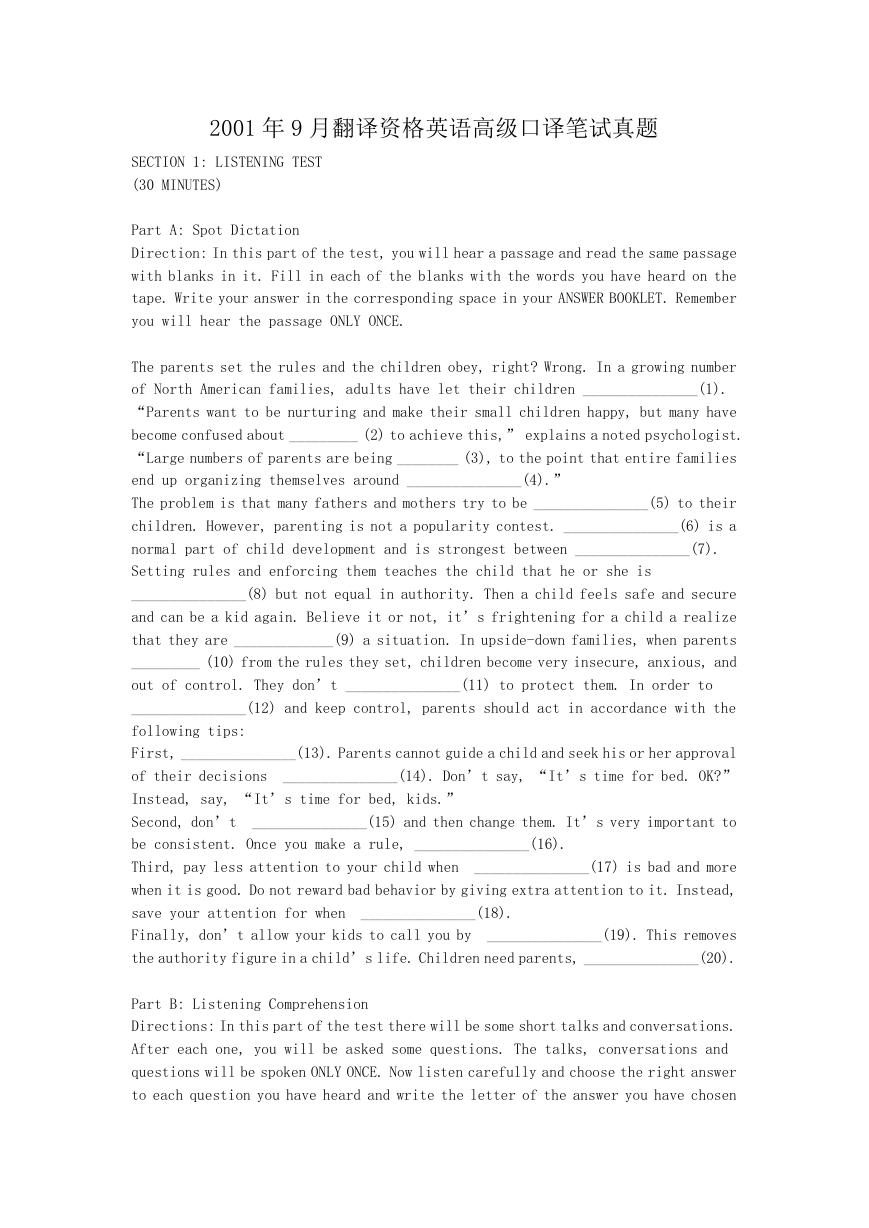
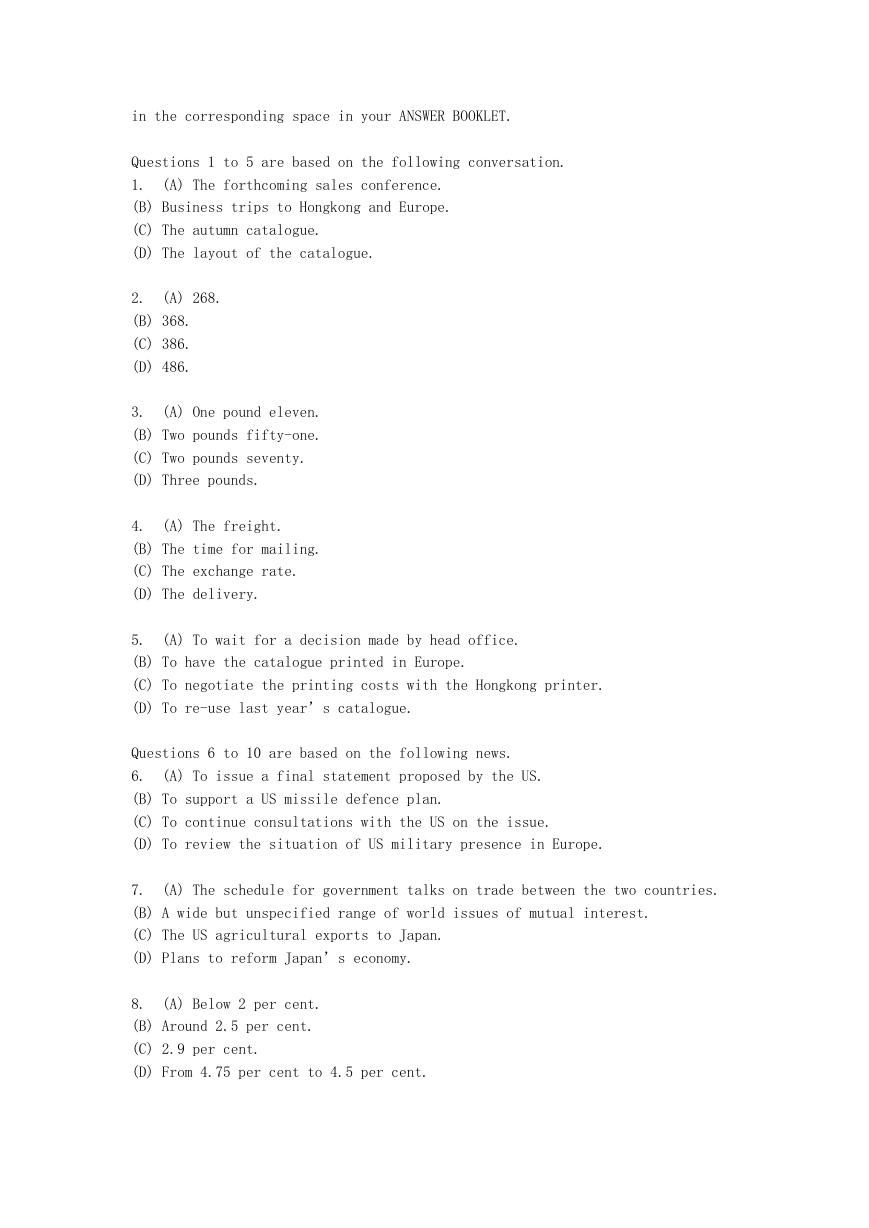

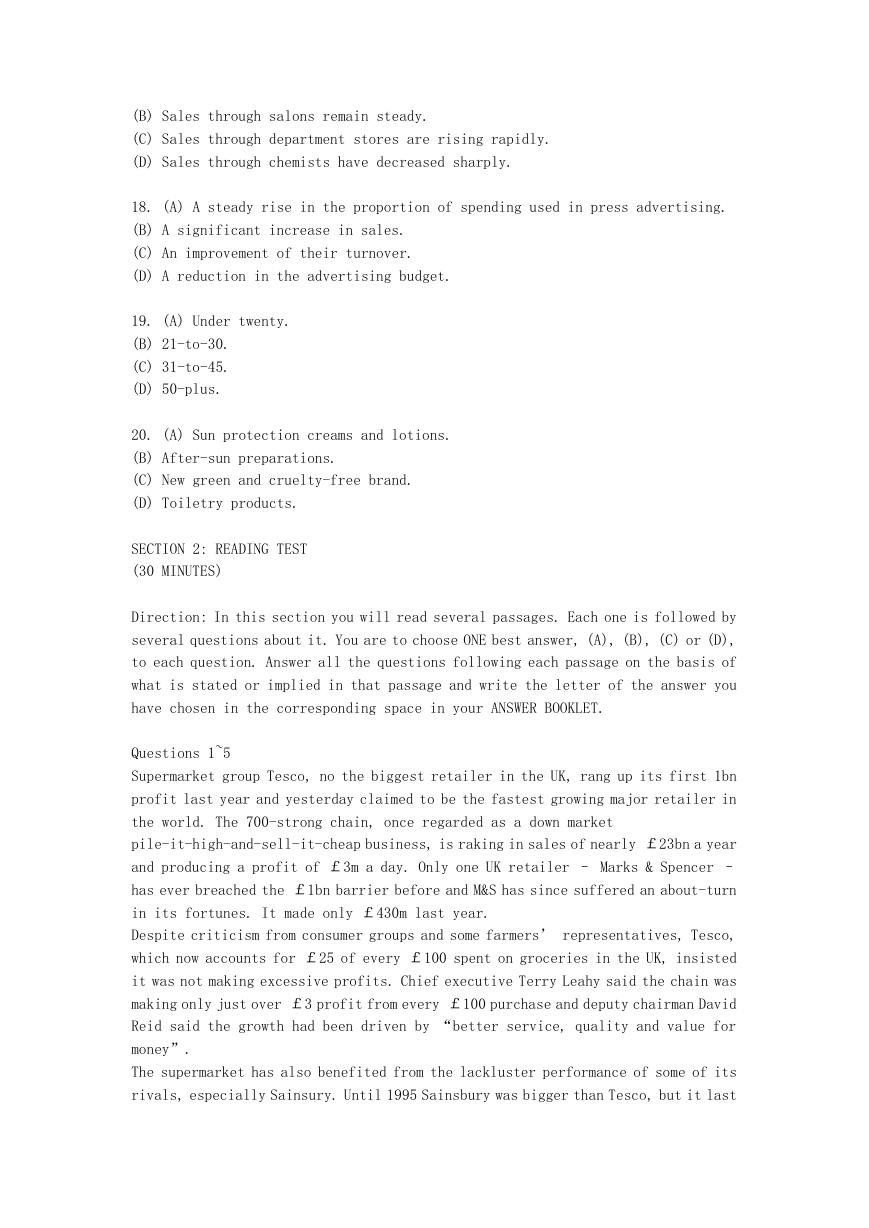
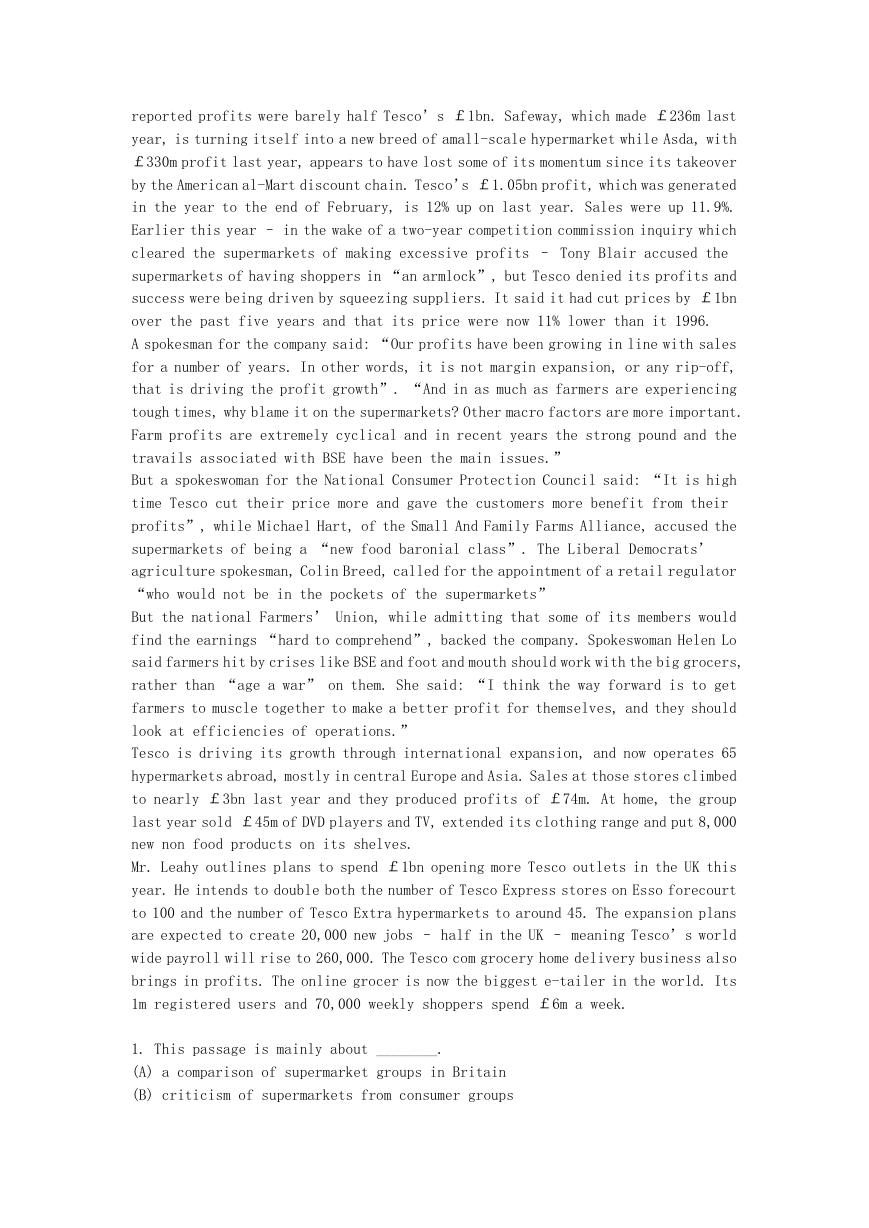

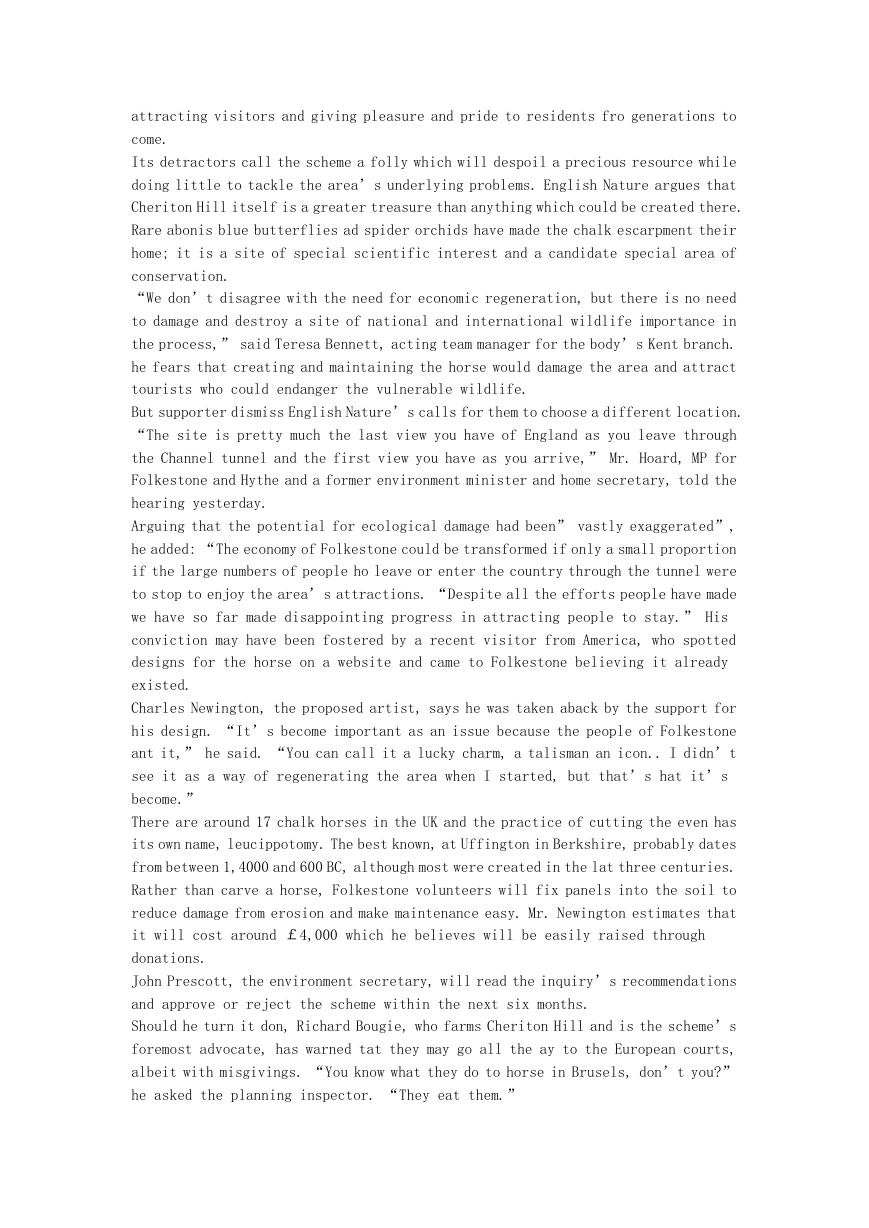









 2023年江西萍乡中考道德与法治真题及答案.doc
2023年江西萍乡中考道德与法治真题及答案.doc 2012年重庆南川中考生物真题及答案.doc
2012年重庆南川中考生物真题及答案.doc 2013年江西师范大学地理学综合及文艺理论基础考研真题.doc
2013年江西师范大学地理学综合及文艺理论基础考研真题.doc 2020年四川甘孜小升初语文真题及答案I卷.doc
2020年四川甘孜小升初语文真题及答案I卷.doc 2020年注册岩土工程师专业基础考试真题及答案.doc
2020年注册岩土工程师专业基础考试真题及答案.doc 2023-2024学年福建省厦门市九年级上学期数学月考试题及答案.doc
2023-2024学年福建省厦门市九年级上学期数学月考试题及答案.doc 2021-2022学年辽宁省沈阳市大东区九年级上学期语文期末试题及答案.doc
2021-2022学年辽宁省沈阳市大东区九年级上学期语文期末试题及答案.doc 2022-2023学年北京东城区初三第一学期物理期末试卷及答案.doc
2022-2023学年北京东城区初三第一学期物理期末试卷及答案.doc 2018上半年江西教师资格初中地理学科知识与教学能力真题及答案.doc
2018上半年江西教师资格初中地理学科知识与教学能力真题及答案.doc 2012年河北国家公务员申论考试真题及答案-省级.doc
2012年河北国家公务员申论考试真题及答案-省级.doc 2020-2021学年江苏省扬州市江都区邵樊片九年级上学期数学第一次质量检测试题及答案.doc
2020-2021学年江苏省扬州市江都区邵樊片九年级上学期数学第一次质量检测试题及答案.doc 2022下半年黑龙江教师资格证中学综合素质真题及答案.doc
2022下半年黑龙江教师资格证中学综合素质真题及答案.doc